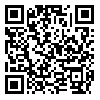Volume 18, Issue 3 (10-2022)
HSR 2022, 18(3): 216-222 |
Back to browse issues page
Research code: 199397
Ethics code: IR.MUI,RESEARCH.REC.1399.556
Download citation:
BibTeX | RIS | EndNote | Medlars | ProCite | Reference Manager | RefWorks
Send citation to:



BibTeX | RIS | EndNote | Medlars | ProCite | Reference Manager | RefWorks
Send citation to:
Hadian-Ghahderijani M, Zamani-Alavijeh F, Ghafouri-Ghahderijani M, Khoshgoftar M. Evaluation of Perceived Anxiety Caused by COVID-19 Pandemic with its Related Factors in the Staff of Isfahan Health Centers, Iran, in 2020. HSR 2022; 18 (3) :216-222
URL: http://hsr.mui.ac.ir/article-1-1341-en.html
URL: http://hsr.mui.ac.ir/article-1-1341-en.html
Maryam Hadian-Ghahderijani1 

 , Fereshteh Zamani-Alavijeh2
, Fereshteh Zamani-Alavijeh2 
 , Marzieh Ghafouri-Ghahderijani1
, Marzieh Ghafouri-Ghahderijani1 
 , Mohadeseh Khoshgoftar
, Mohadeseh Khoshgoftar 

 3
3


 , Fereshteh Zamani-Alavijeh2
, Fereshteh Zamani-Alavijeh2 
 , Marzieh Ghafouri-Ghahderijani1
, Marzieh Ghafouri-Ghahderijani1 
 , Mohadeseh Khoshgoftar
, Mohadeseh Khoshgoftar 

 3
3
1- Student Research Committee AND Department of Health Education and Health Promotion, School of Health, Isfahan University of Medical Sciences, Isfahan, Iran
2- Professor, Department of Health Education and Health Promotion, School of Health, Isfahan University of Medical Sciences, Isfahan, Iran
3- PhD Student, Student Research Committee AND Department of Health Education and Health Promotion, School of Health, Isfahan University of Medical Sciences, Isfahan, Iran
2- Professor, Department of Health Education and Health Promotion, School of Health, Isfahan University of Medical Sciences, Isfahan, Iran
3- PhD Student, Student Research Committee AND Department of Health Education and Health Promotion, School of Health, Isfahan University of Medical Sciences, Isfahan, Iran
Abstract: (867 Views)
Background: With the outbreak and spread of coronavirus disease-2019 (COVID-19), health care workers are more prone to externalize psychological disorders and anxiety due to being in the front line of dealing with disease. The aim of this study was to determine the relationship between the perceived anxiety concerning COVID-19 pandemic with its related factors in health center personnel in Isfahan, Iran, in 2020.
Methods: This cross-sectional study was performed on 357 staff members of health centers in Isfahan. Data collection tools in this study included demographic questions and the standard questionnaire of Corona Disease Anxiety Scale (CDAS). Data were analyzed in SPSS software with a significance level of less than 0.05.
Findings: The mean score of anxiety in health center employees was moderate (12.95 ± 6.40). Psychological symptoms were reported more in women (2.4 ± 12.9) than men (8.4 ± 3.3) (P < 0.001). These symptoms had a significant relationship with occupation (P = 0.030), marital status (P = 0.040), and shift work (P = 0.010).
Conclusion: In line with the findings of the present study, women, nurses, and shift workers should be given the highest priority in intervention programs aimed at reducing anxiety among health care professionals. Given the critical role of female nurses in achieving the success in treating patients, as well as their vital role in improving health and well-being of their families, specific measures should be taken to address the conditions that might lead to their distress.
Methods: This cross-sectional study was performed on 357 staff members of health centers in Isfahan. Data collection tools in this study included demographic questions and the standard questionnaire of Corona Disease Anxiety Scale (CDAS). Data were analyzed in SPSS software with a significance level of less than 0.05.
Findings: The mean score of anxiety in health center employees was moderate (12.95 ± 6.40). Psychological symptoms were reported more in women (2.4 ± 12.9) than men (8.4 ± 3.3) (P < 0.001). These symptoms had a significant relationship with occupation (P = 0.030), marital status (P = 0.040), and shift work (P = 0.010).
Conclusion: In line with the findings of the present study, women, nurses, and shift workers should be given the highest priority in intervention programs aimed at reducing anxiety among health care professionals. Given the critical role of female nurses in achieving the success in treating patients, as well as their vital role in improving health and well-being of their families, specific measures should be taken to address the conditions that might lead to their distress.
Type of Study: Research |
Subject:
education health and promotion
Received: 2021/12/1 | Accepted: 2022/05/28 | Published: 2022/10/7
Received: 2021/12/1 | Accepted: 2022/05/28 | Published: 2022/10/7
Send email to the article author
| Rights and permissions | |
 |
This work is licensed under a Creative Commons Attribution-NonCommercial 4.0 International License. |




